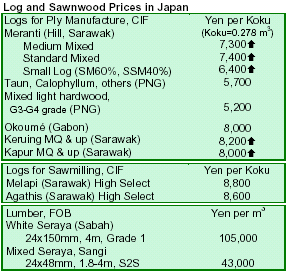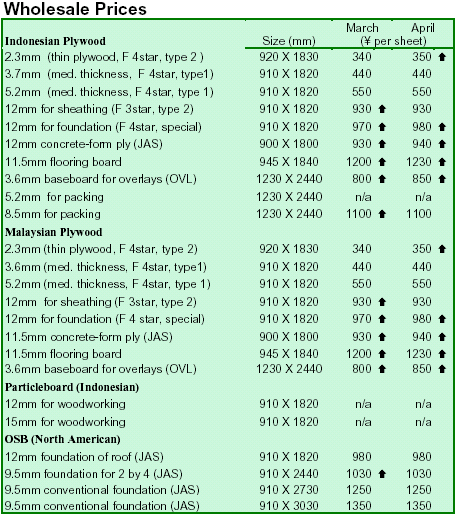|
Japan
Wood Products Prices
Dollar
Exchange Rates of 24th April 2006
Japan
Yen 114.95
Reports
From Japan
Japan’s green procurement policy comes into effect
Japan’s green procurement policy (GPP) for forest goods and services has come into effect on 1 April 2006. The
policy, adopted under the “Law Concerning the Promotion of the Procurement of Eco-Friendly Goods and Services by the State and other Entities”, requires that all timber bought by the state should be legal according to forest laws in producing countries and sourced from forests under sustainable management.
The policy provides guidelines on ways in which importers can verify that products are legal and sustainably produced, including proof of forest certification and chain of custody; industry or association verification; or company’s own verification system (for large companies). Public procurement policies designed to block imports of illegally harvested timber have been adopted in the UK, Netherlands, Norway, Sweden, France and Denmark while Germany is in the process of
developing its own. While environmental critics suggest these laws do not go far enough in preventing trans-shipment of illegally harvested timber through third countries that do processing, some forest producers in developing countries have criticised the proliferation of different import requirements and the costs involved as
non-tariff barriers to their exports. Japan is a member of the pluri-lateral WTO Government Procurement Agreement under which it must treat all foreign companies equally with domestic companies when making public purchases.
Associations to issue GPP certificates to members
Upon Japan’s revision of its green procurement policy (GPP) of wood products for government entities, the Japan Federation of Lumber Association (AJFLA) will give group certificates for local associations representing 20,000 member companies. Details of the group certification will be decided at general meetings of each prefectural lumber association by June 2006.
Other associations such as the Japan Lumber Importers Association (JLIA), Japan Federation of Plywood Manufacturers Association (JFPMA) and Japan Plywood Distributors Association (JPDA) are also considering giving group certificates to their members. To obtain the certificate, wood products such as lumber, plywood, fibreboard and particleboard must come from legal and sustainable sources or recycled materials.
Certified products must be stored separately from non certified products and cannot be mixed during processing, shipment or delivery stages. Companies are required to keep records of the flow of certified products at each stage for three years. JLIA members must report imported volumes of certified and uncertified materials to the association. Consistency of the certification is necessary since standards and procedures vary by country, area and company.
The Japanese government accounts for only 2-3% of the total wood demand in Japan but building materials manufacturers and house builders expect that private consumers will eventually seek certified products too. However, given that prices of imported wood products have risen steadily in the last year due to reduced availability and competition from other consumer
countries, local analysts think that the eventual extension of GPP to all imported wood products will result in further price increases and diversion of supplies to other markets, thus reducing available supply for Japan.
Prolonged log shortage exerts pressure on prices
Although the rainy season is over in Southeast Asian producing regions and log production is recovering, plywood mills are absorbing most of the available logs to meet backlog orders. Large local plywood mills unable to satisfy log needs from their own concessions have been buying from outside sources. This is further reducing the availability of logs for export, exerting additional pressure on FOB prices. In some occasions, idle log ships in Southeast Asian ports waiting for logs to load have to conform to above average prices.
Falling trends in plywood imports remain unabated
Total supply of plywood in February declined to 590,000 m3, down 14% from January and 11% from the same month last year. Imported plywood including blockboard dropped sharply to 331,000 m3, down 26% from January and 17% from the same month last year. Supply of plywood has been tightening particularly of thin panels due to declining imports from Indonesia. Japanese
importers fear that the worsening log availability in Indonesia will result in further declines in plywood supply in the months to come. Conversely, domestic supply of plywood rose 7% to 259,000 m3 in February, but down 1.8% from the same month last year.
Japanese housing starts continue healthy recovery
Total housing starts in February reached 96,995 units, 13.7% more than February last year. Owner’s units were
20,923, up 1.2% from the same month last year and the first increase in three months. Rental units were 39,949, up 16.5% and the eleventh consecutive monthly increase. Units built for sale were 31,602, up 21.5% and the first gain in three months. Wood based units were 39,243, up 2.2% more and the second straight monthly gain. Wooden starts accounted for 40.5% of the housing starts in February, down from 45% in February 2005 and from 43.9% in all 2005. Seasonally adjusted annual starts went
up to 1,334,000 units.



|